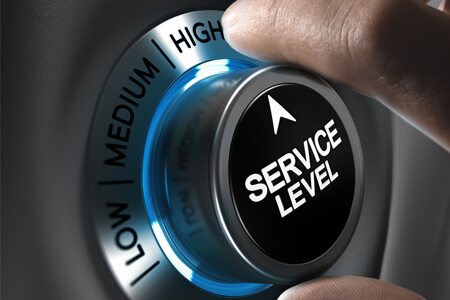
Call Center Metrics: The Numbers We Don’t Look at Drive the Numbers We Do
In the contact center, metrics are always important. Whether in-house or outsourced, you can’t manage what you don’t measure – and measurements drive behavior.
Most of the time, management looks at quantifiable call center metrics that give them some feeling of happiness or despair but may or may not drive agent or customer behavior.
One of the table stakes that we will discuss later on is service level – how fast you answer the customer’s call. Historically, that has been a number that everyone focuses on because it drives so many other things like hiring, the number of agents required on the floor to answer calls, revenue, and the number of support people you need.
But what it may or may not drive is customer service. Just because you answer the call quickly doesn’t mean you answered it correctly – nor does it mean that you actually helped the customer or led them to some sort of loyalty to your product or brand.
Too often, contact center executives look at the wrong numbers and draw the wrong conclusions. Here are some of the numbers we don’t look at that literally drive the numbers we do look at. One example of this is employee satisfaction.
Employee Satisfaction
A satisfied employee will perform with the behaviors you expect and all of the underlying supportive measurements will be met. But a dissatisfied employee can screw up all the metrics.
In the upcoming year, it will be critically important that contact centers pay attention to how satisfied their employees are. What, exactly, does that mean? Start by asking yourself the following questions:
- Are agents being paid enough?
- Are there opportunities for advancement for those who want it?
- Are you creative in your scheduling?
- Are you hiring the right skill set to give them a chance to be productive and successful?
- Do you provide agents with good coaches who develop them to their full potential?
- Do you give them recognition and rewards for the behaviors you want?
- Do you ensure your workplace is safe, encouraging, and even fun?
All of this drives all the rest. If you don’t know the answers to these questions, you need to find out. And if you know, you need to act on it because this describes your culture.
Every call center has its own culture. That culture can be vibrant and successful or it can be caustic and miserable.
Customer Satisfaction
As an industry, the importance of customer service and its impact on revenue, loyalty, and profitability is often discussed. But how do you actually measure customer service with every customer interaction?
How soon after the interaction do you capture the customer’s level of satisfaction and how does their response drive different reactions, coaching or training?
Just look at the example of TripAdvisor and its impact on the hospitality industry. Customer satisfaction can have the same impact on contact centers.
Do you ask customers immediately after an interaction how well they were satisfied? Or, do you send a survey later or do you never find out what they thought? And based on what you discover, how is the feedback loop completed so that agent behavior can be modified? Do coaches understand what needs to be coached and developed? Do trainers understand what needs to change with their training?
Consider this example: A customer calls and asks a question about a specific product or service and the agent either doesn’t know the answer or gives the customer the wrong answer. In either case, the customer is not satisfied with the interaction.
If you discover a customer is not satisfied, how do you trace it back to the individual agent who handled the call? Then, how do you discover the root cause?
Did the agent not have the correct information about the product? Did the product or service being asked about change? Was the agent not told? Was training ineffective? Did coaches not coach it?
If any of these things happened, every contact thereafter will experience the same level of dissatisfaction. It’s a closed-loop process.
Now, look at your current measurements for customer satisfaction. You can measure customer satisfaction on a scale of 1-10, with a simple “yes” or “no,” or you can capture a Net Promoter Score by asking customers if they would be likely to recommend your products and services.
There are multiple ways to ask customers about their level of satisfaction with the interaction they just had. The important thing is to make sure that action happens with that information.
And, by the way, customer satisfaction is one call at a time, every time. So, even if the scores are high, you need to analyze why to make sure they are consistent.
Tune in next month, when we’ll discuss the next two high profile call center metrics to watch in 2015: table stakes and profitability…
Back to Blog
